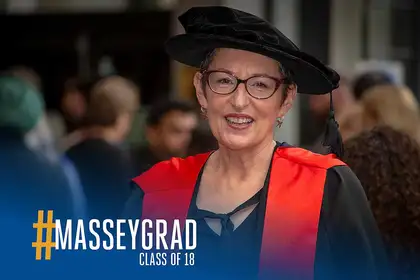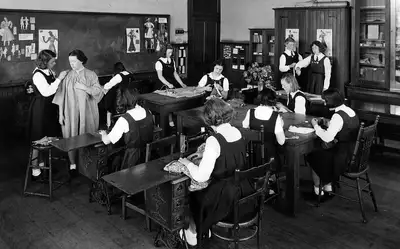
Dr Dinah Vincent explored the hidden threads of history surrounding girls and dressmaking in New Zealand.
In the current age when many people can’t sew a button on a shirt, Dinah Vincent’s PhD thesis reveals a not-too-distant era when dressmaking was a defining, even vital, skill for many New Zealand women.
Dr Vincent, who graduated today with a doctorate from Massey University’s College of Creative Arts ceremony in Wellington, says her thesis – Dressmaking: How a clothing practice made girls in New Zealand, 1945 to 1965 – explores the teaching of sewing skills in schools and the contribution of domestic dressmaking to the, well, fabric of society.
Inspired by her own experience as someone trained in garment design, patternmaking, and construction, she says the study of domestic dressmaking remains “the Cinderella of dress and fashion scholarship, kept largely out of sight”.
In the realm of social history, with a focus on stories and knowledge imparted by investigating artefacts, practices and oral histories about the ‘everyday’, she shines a light on a slice of New Zealand’s recent past that highlights – by contrast – rapid lifestyle changes over the past 60 years.
Her research, she says, fills a gap “in our understanding of dressmaking as a domestic design activity, how it affects decisions about the allocation of time and resources, what it means to the practitioner, and how dressmaking affects a sense of identity”.
While today’s teens can opt to study clothing and fashion design framed as part of a creative commercial industry, her study focuses on New Zealand girls in the period when dressmaking was understood as a universal part of the female experience at home and school.
She explores the heavily gendered nature of sewing classes and the idea at the time that sewing skills reflected the [post-war] need for women to be thrifty with the household budget, as well as helping to make girls into compliant women well-prepared for marriage and motherhood.
She points out that sewing classes were mainly for girls deemed not smart enough for more academic (Latin and French) or commercial (book-keeping and typing) secondary school streams. And sewing teachers were sometimes untrained in teaching. They might even be mothers who taught without pay and brought their own machines to school
And while sewing was synonymous with conforming to conventional female roles, there was a degree of creativity and empowerment too, she says. Women could adapt patterns from dressmaking books to suit their own styles, and some imitated top designers, like French designer Dior, thus finding ways to express their individuality. “The practice is also associated with fantasy, with mastery offering a way of making fantasy into reality,” Dr Vincent says.

The sewing room at Wellington Girls' College, 1947 (image/Wellington Girls' College archive).
Girls in stitches – true stories
As well as studying education policy and curriculum documents from the era, Dr Vincent was keen to capture living memories of the period and interviewed 15 participants who shared their reflections of being young dressmakers.
They shared memories of sewing-centred family lives to school experiences making hand-stitched samplers, of broken machines, volatile teachers and being required to make unglamorous garments such as aprons, tablecloths and “rompers” (baggy, elasticised girls’ shorts for physical education).
Dr Vincent, who is the communications manager at the New Zealand Council for Educational Research and who conducted her project over six years of part-time study, says the topic emerged “from the realisation that both my grandmothers, my mother and my aunts were all dressmakers, while in my generation I am the only one — neither my sisters nor my cousins make clothes.
“As children, my sister and I wore clothes made by our female relatives, from simple cotton dresses to crimplene suits (it was the 1970s). I had sewing classes at school when I was about 11, but I really learned to sew by observation and experiment at home.”
She says her daughters and nieces have no interest in learning beyond what they had to do at school, with strong preferences for ready-made clothing over home-made.
“I thought about how quickly the practice has stopped being an everyday activity for the girls and women in my family, and how it will soon be relegated to memory and anecdote — supported by a few photographs.”
Dr Vincent says her research suggests dressmaking is integral to the person “inside of you”, rather than just a learned skill.